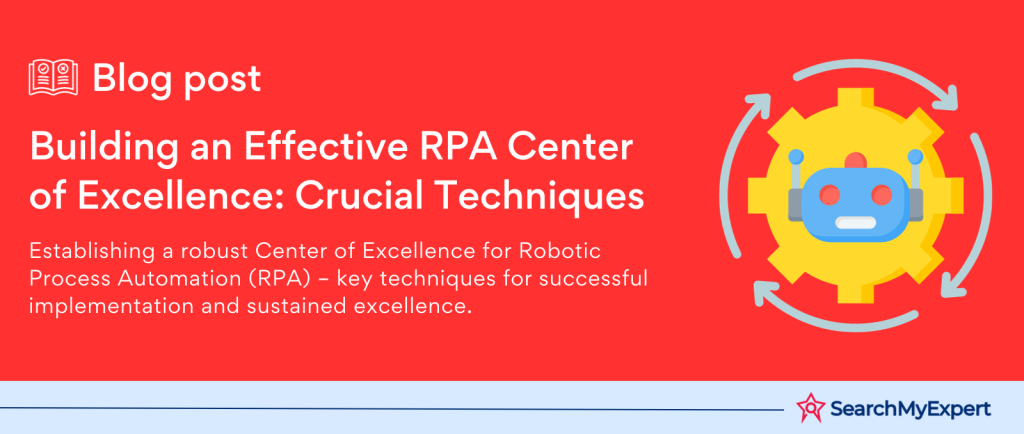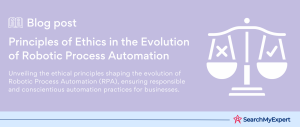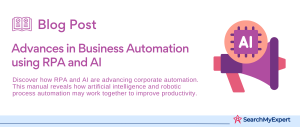Building a Robotic Process Automation Center of Excellence
Unveiling Robotic Process Automation (RPA)
Robotic Process Automation, commonly known as RPA, stands as a beacon of technological advancement in the realm of business process management. At its core, RPA is a software technology that makes it easy to build, deploy, and manage software robots that emulate human actions interacting with digital systems and software. These robots are designed to automate repetitive, mundane tasks that are typically time-consuming for humans, such as data entry, transaction processing, or responding to simple customer service inquiries.
The Benefits of RPA: A Game-Changer
- Increased Efficiency: RPA robots operate tirelessly 24/7, significantly reducing the time taken to complete processes.
- Accuracy and Quality:
With RPA, the error rate is minimal compared to human error, leading to higher quality and reliable output. - Cost Reduction: Automating routine tasks reduces labor costs and operational expenses.
- Scalability: RPA allows businesses to scale operations quickly and efficiently to meet market demands.
- Enhanced Compliance:
RPA ensures adherence to regulatory standards, as the software robots follow the exact process without deviation.
The RPA Center of Excellence (CoE): The Nucleus of Innovation
An RPA Center of Excellence (CoE) is essentially a governance framework that leads the deployment of RPA technologies within an organization. The CoE operates as a centralized unit, focusing on strategizing, managing, and deploying RPA solutions effectively across the business. It aims to cultivate a culture of innovation, ensuring the optimal use of RPA technologies while aligning with the business’s overall objectives.
The Value Proposition of an RPA CoE
- Strategic Alignment:
Ensures RPA initiatives are in sync with the company’s strategic goals. - Standardization:
Promotes best practices and standardizes RPA deployment across various departments. - Expertise and Support: Offers a hub of expertise, providing guidance and support to various teams undertaking RPA projects.
- Performance Measurement:
Facilitates the monitoring and evaluation of RPA’s performance and impact on the business.
Challenges and Opportunities in Building an RPA CoE
Challenges
- Resource Allocation:
Allocating sufficient resources, both in terms of budget and skilled personnel. - Change Management: Managing the organizational change, including employee apprehensions and re-skilling.
- Technology Integration:
Seamlessly integrating RPA with existing systems and technologies.
Opportunities
- Driving Innovation:
Acts as a catalyst for innovation and digital transformation. - Enhancing Operational Efficiency: Streamlines operations, leading to enhanced efficiency and productivity.
- Competitive Advantage: Offers a significant edge over competitors by optimizing processes and reducing costs.
Building an RPA Center of Excellence is a strategic move towards embracing digital transformation, optimizing operational efficiency, and fostering a culture of continuous improvement. While there are challenges, the opportunities it presents are vast and can significantly contribute to an organization’s growth and competitiveness.
Planning and Assessment
Conducting Business Process Analysis for Automation Opportunities
Identifying Automation Candidates
- Process Complexity:
Focus on processes that are rule-based and repetitive, ideal for RPA. - Volume and Frequency:
High-volume and frequent processes offer greater ROI when automated. - Error Rate and Compliance:
Processes prone to human error and requiring strict compliance are prime candidates. - Data Intensiveness: Processes handling a large amount of structured data are suitable for RPA.
- Cross-Application Tasks:
Processes involving multiple software applications are potential automation targets.
Steps in Business Process Analysis
- Process Mapping:
Document current processes, step by step. - Bottleneck Identification:
Spot inefficiencies and time-consuming steps in the process. - Quantitative Assessment:
Gather data on process time, volume, and error rates. - Feasibility Study:
Assess which processes are technically and economically feasible to automate.
Evaluating IT Infrastructure for RPA Readiness
Key Areas to Assess
- Compatibility:
Ensure existing systems and software are compatible with RPA tools. - Scalability: Check if the IT infrastructure can handle increased loads due to RPA.
- Security Protocols:
Assess the security measures to ensure RPA bots operate within a secure environment. - Data Integration:
Evaluate the ease of data integration between RPA tools and existing databases and applications.
IT Readiness Checklist
- Hardware and Software Inventory: List all existing hardware and software resources.
- Network Capacity Analysis:
Ensure the network can support additional RPA data traffic. - Security Assessment: Review cybersecurity measures and data privacy policies.
- Support and Maintenance:
Plan for ongoing IT support and maintenance of RPA systems.
Developing a Strategic RPA Roadmap
Key Components of the Roadmap
- Vision and Goals: Define what the organization aims to achieve with RPA.
- Phased Implementation: Outline a phased approach for RPA deployment.
- Resource Allocation: Plan for the allocation of financial, human, and technical resources.
- Risk Management: Identify potential risks and develop mitigation strategies.
- Performance Metrics: Establish metrics to measure the success of RPA initiatives.
Steps for CoE Formation
- Stakeholder Engagement:
Involve key stakeholders from various departments. - Skill Development:
Plan for training and development of personnel in RPA technologies. - Governance Structure: Establish a governance framework for oversight and decision-making.
- Best Practices and Standards: Develop and enforce best practices and standards for RPA implementation.
The planning and assessment phase is critical in laying a solid foundation for a successful RPA initiative and the formation of an RPA Center of Excellence. It involves a thorough analysis of business processes, a readiness assessment of the IT infrastructure, and the development of a strategic roadmap to guide the entire initiative.
Building the CoE Team and Structure
Defining Key Roles and Responsibilities
RPA Business Analysts: The Strategists
Role: Identify and prioritize potential automation opportunities.
Responsibilities:
- Conduct process analysis and identify high-ROI processes.
- Collaborate with stakeholders to understand business needs.
- Document and map the selected processes for automation.
RPA Developers: The Builders
Role: Design, build, and maintain RPA bots.
Responsibilities:
- Develop RPA bots based on the specifications provided by business analysts.
- Perform testing and quality assurance of the bots.
- Manage bot deployment and ongoing maintenance.
RPA Solution Architects: The Visionaries
Role: Design and oversee the technical infrastructure for RPA.
Responsibilities:
- Develop the overall architecture for the RPA solution.
- Ensure integration of RPA with existing systems and data sources.
- Advise on technical best practices and innovations.
Governance Committee: The Regulators
Role: Establish and enforce RPA policies and standards.
Responsibilities:
- Develop governance frameworks and policies for RPA use.
- Monitor compliance with internal and external regulations.
- Oversee the performance and scalability of RPA initiatives.
Recruiting and Training CoE Personnel
Recruitment Strategies
- Internal Talent Pool: Identify potential candidates within the organization who can be re-skilled.
- External Hiring: Attract talent with proven expertise in RPA and related fields.
- Partnerships:
Collaborate with educational institutions and vendors for specialized roles.
Training and Skill Development
- Customized Training Programs:
Develop training modules specific to RPA technologies and company processes. - Certification Programs: Encourage team members to undertake professional RPA certifications.
- Continuous Learning: Foster a culture of continuous learning and staying updated with the latest RPA trends.
Building a competent and well-structured CoE team is pivotal for the successful implementation of RPA in an organization. By defining clear roles, and responsibilities, and providing adequate training and development opportunities, the CoE can effectively drive the organization’s RPA journey towards operational excellence and innovation.
Establishing Governance and Standards
Developing Clear Guidelines for RPA Bots
Selection, Development, and Deployment
- Selection Criteria:
Define criteria based on process complexity, ROI, and strategic relevance. - Development Standards: Set standards for coding, documentation, and testing of RPA bots.
- Deployment Protocols:
Establish protocols for deploying bots, including user acceptance testing and change management.
Defining Security and Compliance
Security Protocols
- Data Privacy: Implement measures to protect sensitive and personal data handled by RPA bots.
- Access Control: Define strict access control policies for bots, ensuring they operate under secured credentials.
- Audit Trails:
Maintain detailed logs and audit trails for bot activities for traceability and accountability.
Compliance Requirements
- Regulatory Adherence:
Ensure RPA solutions comply with industry and legal standards. - Ethical Guidelines:
Adhere to ethical guidelines, particularly in handling customer data and decision-making processes.
Establishing Performance Metrics
Tracking the Impact of RPA
- Efficiency Gains:
Measure the reduction in process completion times and increased throughput. - Accuracy Improvement:
Track the error rates before and after RPA implementation. - Cost Savings:
Calculate the cost savings achieved through reduced labor and operational efficiencies. - Employee Satisfaction:
Assess the impact of RPA on employee workload and job satisfaction.
Continuous Improvement
- Feedback Loop:
Establish mechanisms for continuous feedback from end-users and stakeholders. - Regular Review: Conduct regular reviews of RPA performance against set metrics.
- Adaptation and Optimization: Use insights from performance tracking to optimize and refine RPA bots and processes.
Developing and Deploying RPA Bots
Prioritizing Automation Candidates
Criteria for Selection
- Feasibility: Assess the technical and operational feasibility of automating the process.
- ROI Potential: Estimate the potential return on investment, considering cost savings and efficiency gains.
- Strategic Alignment: Ensure the process aligns with the organization’s strategic goals.
Design and Development of RPA Bots
Adhering to Best Practices
- Modularity:
Design bots that are modular for easy maintenance and scalability. - Reusability:
Focus on creating reusable components to expedite future bot development. - Error Handling:
Incorporate robust error handling and logging mechanisms.
Standards and Compliance
- Coding Standards:
Adhere to established coding conventions and guidelines. - Security Compliance: Ensure bots meet organizational and regulatory security standards.
- Documentation:
Maintain thorough documentation for future reference and auditing.
Pilot Testing of Bots
Controlled Environment Testing
- Functional Testing: Validate the bot performs as expected in a controlled setting.
- Performance Assessment: Evaluate the bot’s efficiency and effectiveness in process execution.
- Feedback Incorporation:
Refine bot functionality based on test results and user feedback.
Implementation into Live Operations
Deployment and Monitoring
- Gradual Rollout: Introduce bots into live environments gradually to minimize disruptions.
- Performance Tracking: Monitor bot performance continuously for any deviations or issues.
- Iterative Improvement: Apply an iterative approach to refine and optimize bot performance based on ongoing observations.
The development and deployment of RPA bots is a meticulous process that requires careful planning, adherence to best practices, and continuous monitoring. By prioritizing the right candidates, ensuring robust design and development, conducting thorough testing, and carefully monitoring performance in live operations, organizations can realize the full potential of RPA to enhance efficiency and productivity.
Ongoing Optimization and Support
Continuous Monitoring of RPA Bots
Performance and Security
- Performance Analysis:
Regularly evaluate bot efficiency, speed, and accuracy. - Security Checks:
Conduct periodic security assessments to identify vulnerabilities. - Proactive Maintenance: Implement preventive maintenance to avoid potential downtimes.
Providing Ongoing Support and Training
User and Stakeholder Engagement
- User Support:
Offer continuous technical support for end-users of RPA bots. - Stakeholder Training:
Conduct training sessions for business stakeholders to understand and effectively utilize RPA. - Feedback Mechanism:
Establish a feedback loop for users and stakeholders to suggest improvements.
Updating RPA Tools and Technologies
Adaptation to Business Evolution
- Technology Upgrades:
Regularly update RPA software to incorporate new features and improvements. - Process Reassessment:
Re-evaluate automated processes to align with evolving business needs. - Innovation Adoption: Explore and integrate new technologies and methodologies to enhance RPA capabilities.
The ongoing optimization and support phase is crucial for ensuring that RPA bots continue to deliver value and adapt to changing business environments. It involves continuous monitoring, providing robust support and training, and staying abreast of technological advancements to ensure that the RPA solutions remain effective, secure, and aligned with business objectives.
Scaling and Sharing Knowledge
Expanding the CoE’s Capabilities
Broader Automation Initiatives
- Scope Enlargement: Extend CoE’s focus beyond RPA to include AI, ML, and other automation technologies.
- Cross-Departmental Expansion: Broaden the reach of CoE to influence and support automation across different departments.
- Resource Enhancement: Increase resources, both human and technological, to support expanded capabilities.
Sharing Best Practices and Lessons Learned
Knowledge Dissemination
- Internal Workshops:
Conduct workshops within the organization to share insights and best practices. - Collaborative Platforms:
Create digital forums or platforms for knowledge sharing and collaboration. - External Outreach: Engage with external communities and forums to share experiences and learn from others.
Fostering a Culture of Automation
Organizational Integration
- Automation Mindset:
Encourage a mindset shift across the organization to embrace automation. - Employee Involvement: Involve employees in identifying automation opportunities in their work areas.
- Innovation Encouragement: Reward and recognize innovative ideas and initiatives in automation.
Conclusion
Scaling the CoE and sharing knowledge are crucial steps in maximizing the impact of RPA and broader automation initiatives. This involves expanding the scope and capabilities of the CoE, actively disseminating best practices and lessons learned, and cultivating an organizational culture that embraces and drives automation.
Experience innovative automation solutions with our Robotic Process Automation Company.
Further Reading
- Robotic Process Automation in Manufacturing
- Robotic Process Automation and Digital Transformation
- Robotic Process Automation for Small and Medium Enterprises
- Future Trends in Robotic Process Automation
- Robotic Process Automation in Healthcare
- Overcoming Challenges in Robotic Process Automation Adoption
Table of Contents
Toggle






